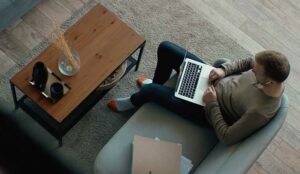C-suite executives and customer contact centre leadership face losing everything if they don’t answer three fundamental questions.
Introduction
Confusion reigns in the world’s leading organisations as to what to do with hybrid working:
- Standard Chartered say YES
- Goldman Sachs and Apple say NO
- Barclays said YES, then they said NO
- Facebook said NO but staff said YES!
“Hybrid working represents the most profound existential crisis to the contact centre industry since its inception,” says Natalie Calvert, Founder of CX High Performance, the exclusive Customer Experience & Employee Experience consultancy.

Natalie Calvert
There is a strong economic case for hybrid-working contact centres, but the operational consequences are certainly far reaching. Many organisations are confused and uncertain. Middle-level management are getting lost in the melee of ‘what do we do next?’
Furlough, office space, performance sustainability – these are all very real and current issues, but they are obscuring the three most important questions facing leadership today:
1. Will you lose your business in an avalanche of unforeseen costs?
There are at least 8 different hybrid models, each with a range of issues, risks, opportunities and costs. Having the right hybrid set-up and organisation will be the most determining factor of corporate success and cost management.
2. Will you lose your staff in the talent war to come?
Location is now becoming agnostic: with the emergence of ‘zoom towns’, staff can, will and are moving. Local and global competitors, within and outside of the sector, will pounce on staff (at all levels) and offer very attractive salary and work-life benefits. Employee power has arrived.
3. Will you lose your liberty through a breach of corporate duty?
In the UK, directors have a clear and legal duty of care for employees wherever they are located. The future for personal injury claims and personal individual claims against directors is already on the agenda of the large insurance companies.
This is a serious issue which is rarely discussed and needs to be fully understood by every director in every boardroom.
Taking Action
To guide C-suite executives and customer contact centre leadership through these very real threats, some of the biggest names in the customer experience contact centre industry have come together, with over 30 years each of experience across every sector for remote and hybrid working.
Graham Hoskins and Stephen Peattie from Kinetic have unrivalled extensive successful experience in contact centre transformational change and operational excellence.
Natalie Calvert of CX High Performance is renowned for her expertise in customer and employee experience. They have formed HybridWorkSMART to specifically address these issues.
The contact centre sector is at the epicentre of hybrid working, impacting over 1 million staff across the UK alone, who, based on an extrapolation of the ONS June 2021 statistics, work an estimated 85% of the time either fully or partially hybrid.
This is an urgent issue for the sector to address. HybridWorkSMART will take a leadership role to guide organisations successfully through the Hybrid maze, so that hybrid working becomes one of the smartest decisions organisations make.
- “No full-time return to the office for over a million. Almost all of 50 of the UK’s biggest employers questioned by the BBC have said they do not plan to bring staff back to the office full-time. Some 43 of the firms said they would embrace a mix of home and office working, with staff encouraged to work from home two to three days a week.” (Source: BBC, 6th May)
- “The Health and Safety at Work Act 1974 is the primary workplace safety legislation. The act makes no distinction between home and in-office workers.” (Source: smallbusiness.co.uk, 26th May)
- “60% of employees are working from improvised workstations. Private healthcare provider BUPA conducted research that found nearly two thirds (63%), equating to 11 million Brits, have injured their back, neck, hips, knees or wrists, amongst other injuries as a result of this.” (Source: YuLife)
- “30% of people were working longer hours as a result of lockdown.” (Source: ONS)
- “Apple wants staff back in offices by September. ‘Video conference calling has narrowed the distance between us, to be sure, but there are things it simply cannot replicate’.” (Source: Tim Cook)
- “Two-thirds of 18- to 24-year-olds admitted that not being offered flexible work patterns would cause them to look for a new job.” (Source: Institute of Workplace and Facilities Management)
See the HybridWorkSMART series of free podcasts and videos to discover more about best practice and the latest thinking.
Author: Guest Author
Published On: 25th Jun 2021 - Last modified: 16th May 2024
Read more about - Guest Blogs, Natalie Calvert















